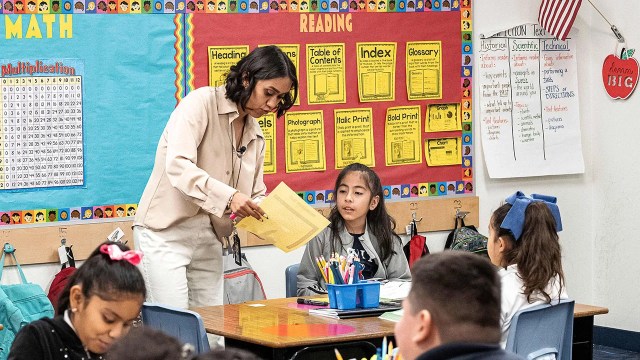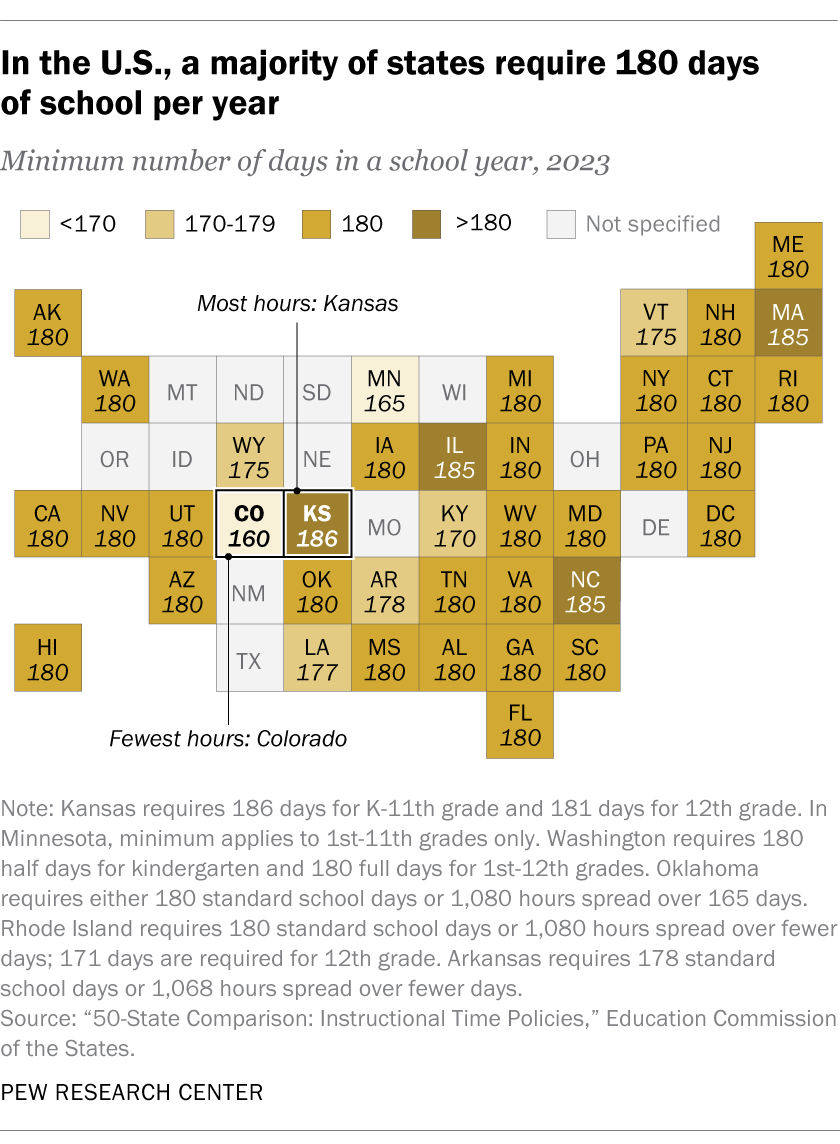

School has started in most of the United States. On average, K-12 public schools will be in session close to 180 days this year, according to a Pew Research Center analysis of data from the Education Commission of the States.
But as with many things involving public education, there is considerable state-by-state variation in how much schooling children will receive – and even how much time constitutes a day of school.
Every state sets rules for the minimum amount of time school must be in session. The minimum is usually some combination of days and hours per year and hours per day; state policies also establish how much, if any, non-instructional time – such as lunch, recess and class changes – can count toward those minimums. Individual districts set their own calendars based on those statewide rules, unless they obtain a waiver.
The most common way that states regulate instructional time is to set a minimum number of days for the school year; 38 states and the District of Columbia do so. The majority of those states (27 of 38), along with D.C., mandate 180 instructional days, making it the closest thing the country has to a national norm.
How we did thisTo better understand how school instructional time varies across the United States, Pew Research Center analyzed information on state laws and regulations compiled by the Education Commission of the States, a nonprofit research organization that serves education policymakers throughout the country. We double-checked the ECS data against the relevant state statutes, rules and policies, updating it as necessary.
Many states’ rules differ depending on grade level, so we chose to look at annual and daily instructional time requirements for four specific grade levels: kindergarten (half-day and full-day, when appropriate), fourth grade, eighth grade and 11th grade. The idea was to get a sense for how instructional time at standard, five-day-a-week public schools compares at each of the major levels of K-12 education – kindergarten, elementary school, middle school and high school. That said, states vary considerably in how much, if any, non-instructional time (such as lunch, recess and class changes) can count toward those minimums.
Some states set separate requirements for how many days or hours districts must schedule versus how many they must operate. (The difference often reflects built-in days for teacher training, weather-related closures and the like.) In such cases, we used the minimum number of days or hours districts must schedule to meet their state’s calendar requirements.
While most of this analysis is based on 2023 data, we also examined similar data for five earlier years. The 2013 and 2014 compilations were also published by the Education Commission on the States. Data for 1989, 2000 and 2018 came from the National Center for Education Statistics. While these earlier datasets provided some illuminating context, they proved too different from one another to permit direct year-over-year comparisons.

Seven states set minimums less than 180 days, with Colorado having the lowest requirement at 160 days. Four states require more than 180 days, with Kansas as the leader. The Sunflower State mandates 186 days for kindergarten through 11th grade (and 181 days for 12th grade). Overall, the average requirement, among the states that have one, is 179 days.
A minimum school year of 180 days has been the norm for a long time. In August 1989, 33 states and D.C. had 180-day requirements, according to a 1992 report from the National Center for Education Statistics. Only one state required more school days that year (Ohio, with 182), while 12 required fewer. The remaining states either had no minimum day requirement or set a range of 175 to 180 days.
Besides setting a minimum number of days, states can regulate school time by mandating a certain number of hours or minutes per school year. Thirty-nine states have these types of laws or policies, according to the Education Commission of the States. (Some states, in fact, give districts the option of meeting either type of minimum – by days or time per year. Oklahoma, for instance, allows school districts to schedule 180 standard school days or spread out 1,080 hours over 165 days.)
In a majority of those states (26 of 39), annual time minimums vary by grade level. For example, South Dakota sets an annual minimum of 875 hours per year for fourth graders but requires 962.5 hours of school for eighth graders.
Across all states that specify annual time minimums, the average for fourth graders is 997.8 hours per school year. For 11th graders, the number of hours required in a school year ranges from 720 hours (including lunch) in Arizona to 1,260 in Texas (though that state expresses its requirements in minutes, not hours). The average requirement for 11th graders, among the 39 states that have one, is 1,034.8 hours per year.
Another option is to require a certain number of hours or minutes per school day, which 29 states and D.C. do. In 16 of those states, the requirements vary by grade level. In Pennsylvania, for example, the minimum length for a school day is 2.5 hours for kindergarten, 5 hours for first through eighth grades, and 5.5 hours for ninth through 12th grades.
For eighth graders, the school day can contain as few as 3 hours in Maryland and Missouri, or as many as 6.5 in Tennessee. New Hampshire and Oregon, intriguingly, set maximums for the length of the school day – in the case of eighth graders, 6 hours in New Hampshire and 8 hours in Oregon. And as with annual time requirements, states vary on how and whether to count lunch, recess and other non-classroom time.
Texas is unique in that it only sets a minimum number of minutes in the school year – 75,600, or 1,260 hours, including intermissions and recess – which districts are free to distribute as they choose. In the past, however, Texas mandated 7 hours per school day, including intermissions, recesses and other non-instructional time. If Texas school districts continue to follow that older convention, that would work out to a school year of … 180 days.

Drew DeSilver is a senior writer at Pew Research Center .